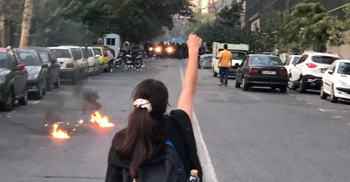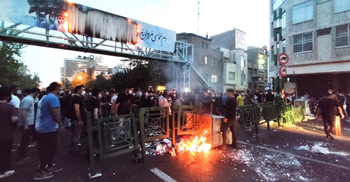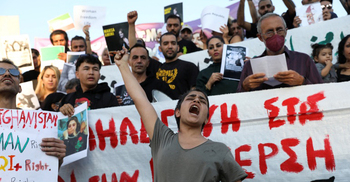Iran’s pro-government counter-protesters try to change narrative

The calls to gather have been coming through announcements and mass text messages.
But with international attention on the protests that have rocked Iran following the death of a woman in the custody of the country’s “morality police”, the mass gatherings called for in the messages have been to show support, not opposition, to the Iranian government.
The calls followed a similar effort two days ago following Friday prayers, which saw thousands join.
The demonstrations are part of an effort by Iran’s authorities to push back against what they have termed the “norm-breaking” behaviour exhibited during nine days of protests across the country since the death of 22-year-old woman Mahsa Amini.
The counterprotests have carried religious symbolism in support of the theocratic establishment that came to power in 1979 following an Islamic revolution, as organisers claimed copies of the Quran and Iranian flags had been burned during the protests.
Government supporters have also denounced what they perceive as foreign intervention in Iran’s affairs, especially by the United States – which has supported the protests and earlier this week said it would make an exception to its comprehensive sanctions regime against Iran to alleviate internet disruptions.
State-organised gatherings have always enjoyed full support from police and security forces and are widely covered by state television and media. Anti-government protests, during which demonstrators often chant slogans against the establishment and its leaders, are not sanctioned and are dispersed by security forces.
The latest pro-government gathering on Sunday comes as President Ebrahim Raisi and other authorities have promised to “deal decisively with those who oppose the country’s security and tranquillity”.
Protests versus ‘riots’
The protests began after Amini, who was arrested for allegedly not following Iran’s dress code for women in Tehran, suffered a stroke and died after several days of being in a coma.
Authorities have said Amini had not been beaten, and attempted to explain her death as the result of pre-existing health conditions, a claim her family denied.
Dozens are thought to have been killed and thousands arrested during the protests so far, but the authorities – who describe the protests as “riots” – have yet to publish official tallies.
State television said on Saturday that at least 41 people have been killed and state media reported “739 rioters, including 60 women”, have been arrested in the northern province of Gilan alone.
Several of those killed were members of the police, security and paramilitary Basij forces, according to the authorities, who also claimed that others had been killed by “infiltrators” from foreign governments and secessionist forces.
A major group accused by authorities has been Komala, a left-wing party seeking independence for ethnic Kurds, which Tehran considers a “terrorist” group.
The Islamic Revolutionary Guard Corps (IRGC) shelled what it said were Komala positions in neighbouring Iraq’s northern Kurdish region on Saturday and Sunday, claiming that the group tried to get “armed teams and a high volume of weapons” into Iran to take advantage of the protests.
According to state media, members of the ISIL (ISIS) “terrorist” group, Komala and the Democratic Party of Iranian Kurdistan, another armed separatist group, have been arrested across several northern and northwestern provinces.
They also reported on Saturday that the IRGC defused a bombing plot in northwestern Tabriz in the East Azerbaijan province.
Online and international reaction
While many in Iran are concerned about separatist groups, protesters in the streets are displaying levels of anger and frustration not seen in years amid the crackdown by security forces.
Videos of the protests continue to come out of cities across Iran despite the largest internet restrictions imposed since the protests in November 2019. The restrictions include the blocking of WhatsApp, Instagram, LinkedIn and Skype, leading to the complete filtering of social media and messaging platforms in Iran.
Authorities appear to have taken a more focused way of restricting internet access than during previous protest waves.
While internet access was completely shut off for almost an entire week in 2019, hobbling access even to local websites and basic government and banking services, the current restrictions are much more calculated and do not interrupt basic services.
In recent days, restrictions have been intensified from about 4pm to midnight, as protests have usually taken place from late afternoon and have carried on through the night.
Restrictions strongly affect mobile phone connections, also making it extremely difficult to connect to virtual private networks (VPNs) that help circumvent internet blocks.
Meanwhile, tech billionaire Elon Musk’s promise to activate his Starlink satellite internet constellation operated by SpaceX to allow restriction-free internet use in Iran has led to trouble, with experts warning that malware claiming to be Starlink software is being deployed by hackers to dupe users.
Outside Iran, the United Nations, the European Union and rights groups have called for independent investigations into the protests and the state response. Demonstrators have also taken to the streets in cities across Australia, Iraq, Germany, Greece, New Zealand, Turkey, Sweden, the United Kingdom and the US to express solidarity with Iranian protesters.
Source: Al Jazeera





